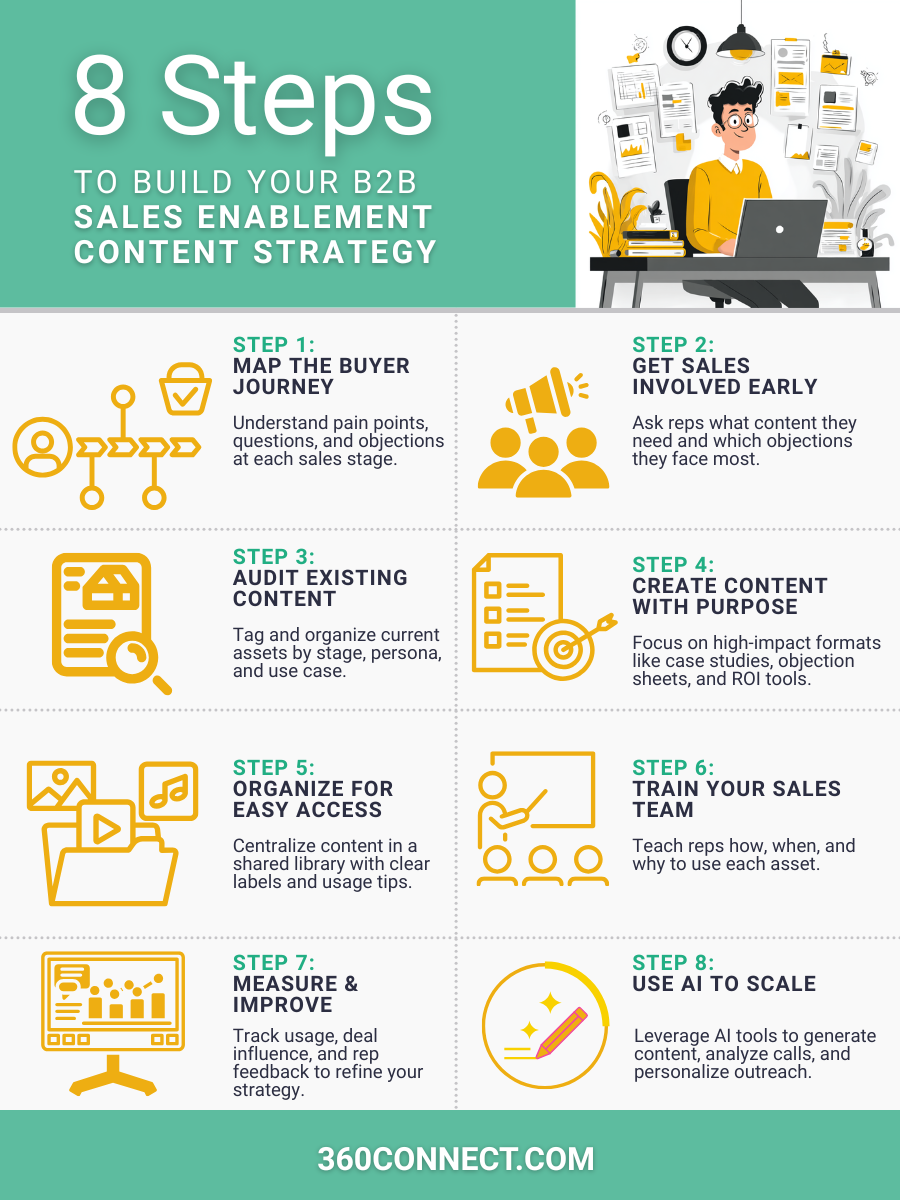In B2B sales, even the most talented reps can’t close deals if they’re not equipped with the right tools. That’s where sales enablement content comes in. It’s not just about writing case studies or whitepapers, it’s about delivering the right message at the right time, tailored to your buyer’s journey. But creating an effective sales enablement content strategy isn’t always straightforward.
If you’re not sure what qualifies as sales enablement content, or you’re trying to figure out how to organize and scale your efforts, you’re in the right place. In this blog, we’ll walk you through the key steps to build a sales enablement content strategy that’s practical, actionable, and results-driven.
Related: How to Grow Your Business With Content Marketing
What Is Sales Enablement Content?
Sales enablement content is any asset created to help sales teams close more deals. Think of it as the bridge between your marketing team and your sales team. It can be internal (like battle cards and objection-handling scripts) or external (like case studies, one-pagers, or email templates).
Good sales enablement content supports reps at every stage of the sales cycle. It provides answers to common objections, reinforces trust, and keeps buyers moving forward.
Some examples include:
- Industry-specific one-pagers
- Product comparison sheets
- Customer testimonials
- Case studies
- ROI calculators
- Pre-written email sequences
- Pitch decks and presentations
Why a Sales Enablement Content Strategy Matters
You can’t just dump a bunch of content in a shared folder and expect results. Without a strategy, your sales team will waste time searching for what they need, or worse, they’ll never use it.
A clear strategy makes sure:
- You’re creating content that actually supports real sales conversations
- The right assets are accessible and up-to-date
- Your marketing and sales teams stay aligned
In addition, a solid content strategy isn’t just a nice-to-have; it delivers real business results. 74% of companies say content marketing has been effective for generating leads, making it a key driver for B2B growth.
How to Build Your B2B Sales Enablement Content Strategy
Now that you know what sales enablement content is and why having a strategy matters, it’s time to roll up your sleeves and actually build one. Whether you’re starting from scratch or revamping your current process, the key is to break it down into manageable steps that align with your sales cycle and team needs.
Here’s how to create a B2B sales enablement content strategy that drives real results, from ideation to implementation.

Step 1: Understand Your Buyer Journey
Before creating any content, map out the B2B buyer journey. This includes every stage from awareness to decision.
For each stage, ask:
- What questions is the buyer asking here?
- What objections might come up?
- What content would help a rep push the deal forward?
Example:
If your prospects tend to stall after a demo, consider adding a tailored case study or an ROI calculator that helps justify the cost.
Step 2: Get Sales Involved Early
Your sales team knows what questions come up on calls. Use that to your advantage. Ask them:
- What content are you missing right now?
- What documents do you share the most?
- What objections are the hardest to overcome?
The more involved your sales team is, the more likely they are to actually use the content you create.
Bonus tip: Record sales calls (with permission) and pull direct quotes. These can inspire FAQ documents or social proof content that feels authentic.
Related: Aligning Sales and Marketing to Generate Quality Leads
Step 3: Audit Your Existing Content
Chances are, you already have some sales enablement content, you just might not realize it. Review your materials and tag them based on:
- Funnel stage (Top, Middle, Bottom)
- Use case (Objection-handling, product explanation, social proof)
- Persona relevance (e.g. CFO vs. IT Manager)
From there, identify gaps and redundancies. Don’t be afraid to repurpose existing marketing content into more sales-focused formats.
Step 4: Create Content With Purpose
When it’s time to create new content, don’t overcomplicate it. Focus on clarity, relevance, and format.
Types of content to prioritize:
- Objection Handling Sheets: Quick-reference guides to common pushbacks
- Mini Case Studies: Short success stories, ideally industry-specific
- Comparison Charts: Visuals that show how you stack up against competitors
- Email Templates: For outreach, follow-ups, or re-engagement
- ROI Tools: Calculators that help justify cost or show value
Step 5: Organize It All for Easy Access
Even the best content won’t help if your team can’t find it. Create a centralized, easy-to-navigate content library. Whether it’s in your CRM, shared drive, or enablement platform, the key is accessibility.
Group content by:
- Sales stage
- Industry
- Persona
- Objection type
Also, consider labeling each asset with metadata so sales reps know when and how to use it.
Step 6: Train Your Sales Team
Roll out your content with clear guidelines. Don’t just upload it, teach your team how to use it.
Host a short internal training that covers:
- What new content is available
- When to use it in the sales cycle
- Where to find it
- How to personalize it
If you can, build short training videos or cheat sheets to make it even easier.
Step 7: Measure, Iterate, Repeat
Your strategy doesn’t end once the content is live. You need to know what’s working and what’s not.
Track:
- Usage rates (which content gets opened/shared)
- Influence on deal progression
- Feedback from sales team
- Closed-won rates tied to content use
Make this part of your regular sales-marketing sync. Use real feedback to refine and improve your library over time.
Step 8: Leverage AI to Scale and Personalize
AI tools can supercharge your sales enablement content strategy, especially when it comes to scaling content, personalizing outreach, and improving efficiency.
You can use AI to:
- Generate custom content for different industries or buyer personas (Related: How to Use AI for Lead Generation)
- Summarize long-form pieces into quick-reference formats (great for turning a blog into a one-pager or battle card)
- Personalize outreach at scale with smart email tools
- Analyze performance data to identify which content drives results
91% of B2B marketers who use AI utilize free tools like ChatGPT.
Tools like ChatGPT, Lavender, and Grammarly can help your team write faster and sound more professional, while others like Gong or Chorus use AI to analyze call data and present the content reps actually need.
Just remember: AI is a tool, not a replacement for strategy. The best results come when you combine AI with real buyer insights and feedback from your sales team.
Essential Content Types for Sales Enablement
By now, you’ve seen examples of the content your sales team might need, like case studies, ROI tools, and product one-pagers. But to build a truly effective strategy, it helps to take a step back and look at all the content types available, organized by purpose.
Here’s a more complete breakdown of the essential content you’ll want in your sales enablement library:
Customer-Facing Content
These are assets reps can send directly to prospects to inform, educate, and move the deal forward:
- Product one-pagers
- Solution overviews
- Case studies and testimonials
- Competitive comparison sheets
- ROI calculators
- Pricing guides
- Product demos and video walkthroughs
Internal Sales Tools
These resources are for your sales team only. They help guide conversations and keep messaging consistent:
- Sales battle cards (competitive quick-reference guides)
- Sales playbooks (standardized sales processes)
- Objection handling scripts
- Persona and buyer guides
- Email templates and call scripts
- Internal FAQs and cheat sheets
Content by Funnel Stage
You’ll also want to map your content to each stage of the sales cycle:
- Top of Funnel (TOFU): Educational blogs, explainer videos, industry stats
- Middle of Funnel (MOFU): Case studies, product explainers, comparison charts
- Bottom of Funnel (BOFU): Testimonials, ROI tools, pricing sheets, technical specs
The best sales enablement content strategy includes a mix of all three types, so your reps have what they need before, during, and after every call.
Benefits of a Strong Sales Enablement Content Strategy
A well-executed sales enablement strategy doesn’t just help sales reps, it transforms how your entire team works and how buyers experience your brand.
Here’s what you stand to gain:
- Faster Sales Cycles: Reps spend less time searching for content and more time closing.
- Higher Win Rates: Tailored, well-timed content makes it easier to overcome objections and build trust.
- Improved Sales-Marketing Alignment: Everyone’s working toward the same goal with shared tools and messaging.
- Scalable Growth: Once your content system is in place, it’s easier to onboard reps and reach new markets without reinventing the wheel.
- Better Buyer Experience: The right content, shared at the right time, builds credibility and confidence with prospects.
Final Thoughts on Sales Enablement Content Strategy
When done right, a sales enablement content strategy isn’t just helpful, it’s a competitive advantage. It keeps your sales team aligned, empowers reps to handle objections faster, and creates a smoother experience for your buyers. Most importantly, it makes your content actually drive revenue instead of collecting digital dust.
The key is to stay organized, listen to your sales team, and keep improving as your buyers evolve.
Get the Leads Your Strategy Deserves
Want to connect with more qualified buyers who are actively in the market for your product or service? That’s exactly what we help with. At 360Connect, we help B2B suppliers like you get verified leads, so your sales team can do what they do best: close deals.
Start growing your business today—Join 360Connect.

